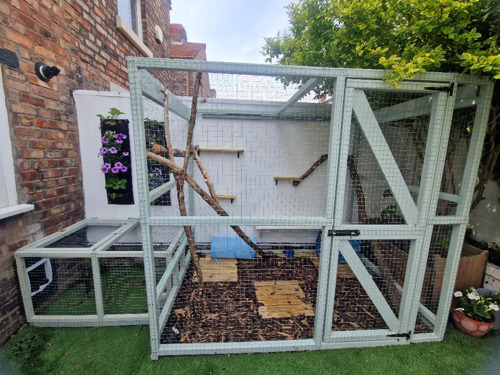Which cats would benefit from an outdoor cat enclosure? Find out how to build the perfect catio
Catios are becoming more popular with cat owners. They’re designed to provide cats with outdoor access while keeping them safe from outdoor hazards such as road accidents and other animals. They're also intended to protect wildlife from cats who are keen hunters. But are catios actually beneficial for cats? Here's expert advice on the advantages and drawbacks of catios. Is a catio the right choice for your cat?
What is a catio?

A DIY catio built by cat owner Beth Easton and her husband
A catio, short for ‘cat patio’, also known as a cat enclosure, is an enclosed outdoor space for cats. It can be built onto the side of your home with direct access for your cat. They can vary in design and size. They range from window boxes to large structures with perches, shelters and climbing opportunities. The purpose of a catio is to give your cat outdoor access while preventing them from roaming freely.
Alternatives to catios
- Balcony enclosures. These involve enclosing your balcony from floor to roof with netting or wire mesh. They allow your cat to safely explore the balcony without the danger of falling over the edge
- Cat fencing. This includes angled overhangs or horizontal poles on the tops of the fences or walls surrounding your garden. This keeps your cat in your garden by preventing them from climbing up and over
- Pens and runs. A bit like rabbit runs, these are freestanding enclosures that are not joined to the house. These are not recommended for cats as the cat has to be placed inside instead of having free access. This can make the cat feel trapped and stressed as they do not have the choice of whether to be in or out of the enclosure
Would a catio be good for my cat?
Catios are good for cats who need to be kept indoors. Perhaps because of a disability, old age or other health issues. They can provide these cats with extra space and mental stimulation. Cats are able to explore the sights, sounds and smells of the garden safely. Indoor cats should still be provided with a suitable indoor environment too. Make sure they have essential items such as litter trays and scratch posts, and plenty of opportunities to play to prevent boredom. Find more advice about caring for indoor cats.
Catios should not be seen as a replacement for giving outdoor cats free outside access. Cats like to explore, often roaming beyond the boundaries of their garden. Restricting their outdoor space could cause them to become frustrated and stressed. If you’re worried about your cat’s safety outside, find our advice on keeping cats safe outdoors.
How to build a catio

Beth Easton's DIY catio
When installing a catio, you can use your DIY skills and build it yourself. Or there are companies who will provide all the materials and build it for you. The most important thing is to make sure the catio is completely secure. Make sure your cat won’t be able to escape, and other animals won’t be able to get in.
- Materials. If you’re creating your catio with a wooden frame, make sure the wood is treated to protect it from the weather and insects. Any treatment, stain, varnish or paint you use must be non-toxic to cats. Look for products with no or low volatile organic compounds (VOCs) and that are water based. Most of the catio should be made from a wire or metal mesh. This will allow plenty of fresh air in and let your cat see their surroundings. Make sure it’s sturdy enough so that your cat can’t claw or chew their way out and other animals can’t claw or chew their way in
- Floor. Make sure the floor of the catio is comfortable for your cat to walk on. Grass, paving, decking or wood chips are good options. Most cats won’t want to walk on muddy soil or gravel. Make sure there is no way for your cat to dig their way out of the catio, or for other animals to dig their way in
- Roof. You could opt for a solid roof for the catio, so your cat will be sheltered from the rain, or you could have a mesh roof. Your cat should have access to inside the house at all times, in case they want to escape the weather
Features of the perfect catio

Beth Easton's cat Loki using the catio
- Free access. Your cat should be able to access the catio directly from the house via a cat flap, window or door. They should be able to choose when to go into the catio. They should also be able to get back inside the house at all times. This is in case they get scared of something outdoors or need to access their litter tray, food or water.
- Hiding places. Your cat may feel a little exposed and vulnerable in their catio. Provide them with a covered hiding area, such as a box. Hiding helps cats to feel safe if they’re scared, anxious or stressed. This will also provide them with somewhere to shelter from the rain or shade themselves from the sun. Find out more about cats and hiding.
- Perches. Cats like to climb and get up high. This gives them a good view of their surroundings so they can watch out for any potential danger. Include some shelves, perches or other climbing apparatus in the catio. This will help your cat to feel safe and give them a good vantage point for watching the rest of the garden.
- Scratch posts. Scratching is a natural behaviour for cats. It helps them to keep their claws in good condition and also mark their territory. Include some scratch posts or logs of wood inside the catio. This will give your cats something to scratch while they enjoy the outdoors. Find out more about cats and scratching.
- Cat-safe plants. To give your cat some interesting sights and smells inside the catio, you could add some plants. Cats love catnip and buddleias, and you could even get them some cat grass to chew on. Make sure any plants you include are not poisonous to cats. Find our guide on dangerous plants for cats.
- Toilet. You could provide your cat with an outdoor toilet in their catio. Place a litter tray out there, or create a patch of sand or fine soil that they can toilet in and dig over. Cats like to toilet in private. Try concealing the toileting area behind some tall plants or plant pots. Make sure you still provide your cat with a litter tray indoors too. They should have the choice to use this if they’re not comfortable with their outdoor toilet. Find out more about cats and toileting.
- Water. It’s a good idea to give your cat some fresh water to drink in their catio, particularly on hot days. Leave them a bowl of water, or you could even get a water fountain, as some cats prefer to drink moving water. Make sure they always have access to fresh water inside the house too. Find out more about cats and drinking.
- Food. You can feed your cat in their catio, but make sure you don’t leave food out there unattended for long periods of time. This could attract insects and other animals. Find more advice about feeding your cat.
If you have more than one cat, they likely won’t want to share items such as hiding places, scratch posts, toilets, water bowls and food bowls. Provide each cat with one of these essential items each, plus a spare, both inside the house and in the catio.
How to introduce cats to a catio

Beth Easton's cats Loki (top) and Rupert (bottom) enjoying the catio
It may take your cat a bit of time to get used to their new catio, so be patient with them and take things at their own pace. Before letting your cat out into their catio, make sure they are neutered, vaccinated and microchipped, in case they do manage to escape. Also make sure the microchip details are up to date.
When introducing your cat to the catio for the first time, it’s a good idea to pick a day when the weather is warm, calm and dry. Also make sure there is unlikely to be any loud noises outdoors, such as lawn mowers or garden parties. This will ensure the catio is more inviting for your cat.
Always let your cat enter and explore the catio of their own accord. Don’t pick them up and put them in the catio, as this could cause them stress and put them off using the catio in future. Also, never shut your cat in the catio, as this will make them feel vulnerable. Make sure they can always get back into the house if they want to.
If your cat is reluctant to use the catio, try propping open the cat flap, door or window so they can see outside. Then go out there yourself and try luring them with a treat or their favourite toy. You may need to keep the cat flap propped open for their first few trips into the catio, so they can see their route back indoors. Once they’re feeling more confident, you can close the cat flap but leave it unlocked. This means they can still go indoors whenever they want to. Find out how to train your cat to use a cat flap.
Unfortunately there is no guarantee your cat will want to use the catio once you’ve built one. Some cats may feel safer staying indoors. But if you follow our tips for making the catio an enticing cat-friendly environment, and always give them choice to access or leave the catio when they want to, they will be more likely to use it.


